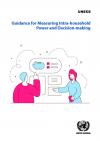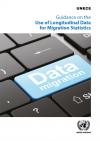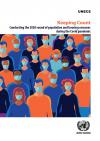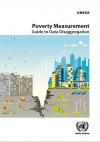Publications
Displaying Results 21 - 40 of 122
- English
Unequal power relations operate not only in the public world but also in the private sphere, within households. This Guidance has been developed to support national statistical offices in developing ways to measure power in the private sphere, looking at who usually makes decisions about a variety of matters, from routine grocery shopping to saving up for a car, and from seeing a doctor to
- English
As the number of international migrants has grown, it is becoming increasingly important for the public and policymakers to understand migratory flows and the impact of migration on individuals, families, societies and economies. For this, it is necessary to look at change over time, as underscored in the Global Compact for Safe, Orderly and Regular Migration. A longitudinal approach where
- English
When the Covid-19 pandemic broke out in March 2020, preparations for the 2020 round of population and housing censuses were well underway in countries across the UNECE region: some were already in the field, while the majority were in the advanced stages of planning for a 2021 census.
The impacts of the pandemic on census-taking have been wide ranging; from the need for social distancing in
- English
This publication provides guidance on applying various approaches to data disaggregation for measuring poverty and aims to improve the international comparability of poverty statistics. Regardless of how accurate the national measures of poverty are, their usefulness will be limited if they mask existing disparities within societies.
The introductory Chapter 1 lays down the
- English
Gender statistics, like statistics on any other topic, are valuable to users only if they are easily found and accessible, and if users find them relevant and easy to understand. National statistical offices must take extra care when communicating gender statistics to balance the need to remain impartial with the obligation to produce relevant data to inform policymaking and answer the
- English
The population census is not just about counting how many people live in a country, but also providing information about age, sex, and other key characteristics that allow countries to paint a picture of how different groups, with different needs, are spread out across the country. In fact, the census provides the foundation for many statistics that help us make informed decisions
- Pусский
Statistics on social and demographic topics are usually produced from surveys of private households. People living in institutions are often excluded because it can be complicated and expensive to identify and sample the institutions and their residents.
But populations across the UNECE region and throughout the world are growing older, and for many countries this means that the population of
- English
Statistics on social and demographic topics are usually produced from surveys of private households. People living in institutions are often excluded because it can be complicated and expensive to identify and sample the institutions and their residents.
But populations across the UNECE region and throughout the world are growing older, and for many countries this means that the population of
- English
The world is becoming more interconnected, with an acceleration in the movement of information, capital, goods, services and people across international borders. As it becomes easier to travel and work in other countries – especially in common market areas such as the European Union – the expansion of international labour mobility has become a topic of growing policy importance.International
- English
Migration shapes societies. Its economic, social and demographic impacts are large and increasing. Policymakers, researchers and other stakeholders need data on migrants – how many there are, their rates of entry and exit, their characteristics, and their integration into societies. These data need be comprehensive, accurate and frequently updated. There is no single source that can
- English
The purpose of this publication is to guide national statistical offices and other responsible agencies on the use of registers and administrative data in population and housing censuses, including operational, practical, technical and legal aspects.
The publication was prepared by a task force established by the Conference of European Statisticians (CES), composed of experts from
- English
This publication contains a series of good practices and recommendations on effectively communicating the results of population projections. Here, “communication” encompasses not only how projections should be disseminated to users, but also what should be communicated. The aim is to improve the coherence between what is produced by national statistical offices and what is needed by users,
- English
Conventional economic statistics, such as national accounts and employment measures, are largely designed to measure the market economy and in most countries exclude unpaid household service work. Economists have argued for many years that ignoring these services introduces biases in various areas of economic analysis. For instance, an increase in childcare or long-term care provided by the
- English
The 2nd edition of the Road Map, published in February 2022, can be found here.
The publication provides guidance to national statistical offices on producing statistics for SDGs. It lays out what needs to be done, who are the stakeholders, and what are the opportunities for cooperation. The Road Map deals with
- English
Circular migration – a repetition of migration by the same person between two or more countries – is a topic of growing importance, on which information is needed for policy development. To meet this demand, tools must be established to better measure the extent to which existing international migration patterns become more (or less) circular over time and to evaluate policies aiming at
- Pусский
Миграция является мощным драйвером и важным следствием экономических, политических и социальных изменений. Поэтому ее необходимо соответствующим образом измерять и понимать. Тем не менее, совершенствование статистических систем по измерению миграции проходит медленно из-за слабого взаимодействия между производителями статистических данных по миграции, расхождениями в применяемых определениях и
- English
Migration is a powerful driver and important consequence of economic, political and social change, and therefore needs to be adequately measured and understood. However, the improvement of statistical systems to measure migration has been a slow process because of weak coordination between migration statistics producers, discrepancies in the applied definitions, and challenges related to data
- English
The population and housing census provides, at regular intervals, information on the number and characteristics of the population of a country, and on its housing stock. It is an essential source of information for small-area, national, regional and international planning and development. This publication reviews the practices followed by countries in Eastern Europe, Caucasus and Central
Conference of European Statisticians Recommendations for the 2020 Censuses of Population and Housing
- English
The main objectives of the Conference of European Statisticians Recommendations for the 2020 Censuses of Population and Housing are: to provide guidance and assistance to countries in the planning and execution of their population and housing censuses; and to facilitate and improve the comparability of census at the UN regional level through the identification of a core set of census topics
- English
The increased movement of people across international borders has brought the issue of migrant integration to the forefront of national polices. International migration can have great societal and economic impacts, both positive and negative, on both individuals and countries of origin and destination, particularly when viewed through the lens of time. Thus, improved measurement of








